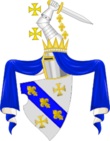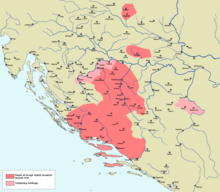Hrvatinić
| Hrvatinić | |
|---|---|
 Coat of arms of Hrvoje Vukčić Hrvatinić, Grand Duke of Bosnia | |
| Country | Banate of Bosnia Kingdom of Bosnia Kingdom of Hungary[1] |
| Founded | fl. 1299 |
| Founder | Hrvatin |
| Current head | Extinct |
| Final ruler | Matija Vojsalić |
| Titles | Count Duke Grand Duke of Bosnia |
| Estate(s) | Lower Edges, Western Sides in Bosnia, Dalmatia |
| Dissolution | 1476 |
| Cadet branches | Vojsalić, Dragišić |

Hrvatinić family was a Bosnian medieval noble family that emerged in Donji Kraji county, located in today's territory of western Bosnia and Herzegovina. Principally they were vassals to Kotromanić dynasty of the Banate of Bosnia and Kingdom of Bosnia, occasionally also to the Kingdom of Hungary, changing loyalties between Hungarian kings Ladislaus of Naples and Sigismund of Luxembourg, and finally the Ottoman Empire (1472–1476).[1] They rose to prominence in the second half of the 14th century, and attained its peak under magnate Hrvoje Vukčić Hrvatinić (1350–1416), who also held large swaths of Dalmatia and obtained title of Grand Duke of Bosnia in 1380.
Its eponymous founder was Hrvatin (fl. 1299–1304), a count and holder of possession in parts of "Donji Kraji" (English: Lower Ends) and "Zapadne Strane" (English: "Western Sides"), and a vassal of Croatian magnate Paul I Šubić of Bribir.[2] Hrvatin's sons was part of a coalition of Bosnian and Slavonian nobility that revolted against Mladen II Šubić of Bribir between 1316 and 1317.[3] From around 1322 the family submitted to the Kotromanić dynasty of the Banate of Bosnia.[4] In 1363, the Hrvatinić supported Tvrtko I of Bosnia against Hungary, after which they came up through the ranks in Bosnia, while their most prominent member, Hrvoje Vukčić, along with major new possessions in Donji Kraji and Zapadne Strane was awarded with the title Grand Duke of Bosnia.[5] In c. 1387, while loyal to Tvrtko I, they supported rebellion in Dalmatia against Sigismund.[5] The last member of the family was Matija Vojsalić who was last mentioned in the archives of Republic of Ragusa in 1476. He was installed as a puppet king of Bosnia by the Ottoman sultan as an answer to Nicholas of Ilok, named king of Bosnia by Matthias Corvinus. Matija Vojsalić was removed after conspiring with Matthias Corvinus against the Ottomans and was not mentioned after that.
Lineage[]
- Stjepan or Stipan (Latin: Stephan; died before 1301),[6] according to F. Šišić possibly knez in Donji Kraji, possibly as early as 1244.[7]
- Hrvatin (Latin: Horvatinus, Huruatin; fl. 1299–1304), knez (count) in Donji Kraji of Bosnia (de inferioribus Bosne confinibus[2]) and vassal of Paul I Šubić of Bribir.[8][9] Believed by F. Šišić to have died around the same time as Paul I (1312).[10] He had three sons.[10] Called Hrvatin Stjepanić or Hrvatin Stipanić in Croatian historiography.
- Vukoslav Hrvatinić (Latin: Vlkosslaus; fl. 1315–1326), issued a charter in 1315 in Sanica.[7] In ca. 1326, Ban Stjepan II in a land grant mentioned that Vukoslav "had left the Croatian lord".[11] Served as count of Ključ (fl. 1325).[12] Married Jelena, the daughter of Count Kurjak.[13]
- Pavao Hrvatinić (fl. 1323–1332)
- Grgur (fl. 1357)
- Vladislav (fl. 1357)
- Vukac Hrvatinić (fl. 1357–1366), defended the Soko fortress in the Pliva county in ca. 1363 against the Hungarians, for which he was awarded a large land grant by Tvrtko.[14]
- Hrvoje Vukčić Hrvatinić (1350–1416), Grand Duke of Bosnia (1380), Ban of Croatia (1403).
-
-
- Hrvatin (Latin: Horvatinus, Huruatin; fl. 1299–1304), knez (count) in Donji Kraji of Bosnia (de inferioribus Bosne confinibus[2]) and vassal of Paul I Šubić of Bribir.[8][9] Believed by F. Šišić to have died around the same time as Paul I (1312).[10] He had three sons.[10] Called Hrvatin Stjepanić or Hrvatin Stipanić in Croatian historiography.
See also[]
References[]
- ^ a b Sulejmanagić, Amer (23 July 2015). "Grbovi Vukčića Hrvatinića" (html, pdf). Povijesni prilozi (in Serbo-Croatian). hrcak.srce.hr. pp. 33–68. Retrieved 28 February 2019.
- ^ a b Klaić 1989, p. 193.
- ^ Fine 1994, p. 211.
- ^ Fine 1994, p. 278.
- ^ a b Fine 1994, p. 397.
- ^ Šišić 1902, p. 7.
- ^ a b Šišić 1902, p. 243.
- ^ Šišić 1902, pp. 7, 9, 243.
- ^ Klaić 1989, p. 185.
- ^ a b Šišić 1902, p. 9.
- ^ Ančić 1997, p. 113.
- ^ Šišić 1902.
- ^ Ančić 1997, p. 135.
- ^ Fine 1975, p. 107.
- ^ a b Kurtović 2009, p. 59.
Sources[]
- Ančić, Mladen (1997). Putanja klatna: Ugarsko-hrvatsko kraljevstvo i Bosna u 14. stoljeću. Acad. Scientiarum et Artium Croatica. ISBN 978-953-154-308-8.
- Fine, John V. A., Jr. (1994). The Late Medieval Balkans: A Critical Survey from the Late Twelfth Century to the Ottoman Conquest. Ann Arbor: University of Michigan Press. ISBN 978-0-472-08260-5.
- Fine, John V. A., Jr. (1975). The Bosnian Church: a New Interpretation : a Study of the Bosnian Church and Its Place in State and Society from the 13th to the 15th Centuries. East European Quarterly. ISBN 978-0-914710-03-5.
- Klaić, Nada (1989). Srednjovjekovna Bosna: politički položaj bosanskih vladara do Tvrtkove krunidbe, 1377. g. Grafički zavod Hrvatske. ISBN 9788639901042.
- Kurtović, Esad (2009). Veliki vojvoda bosanski Sandalj Hranić Kosača. Vol. Book 4 (Historijske monografije ed.). Institut za istoriju. ISBN 9789958649011.
- Šišić, Ferdo (1902). Vojvoda Hrvoje Vukčić Hrvatinić i njegovo doba. (1350-1416): s jednim tlorisom i zemljovidom te s četiri redoslovne table. Izdanje "Matice hrvatske".
External links[]
- Hrvatinići - Enciklopedija.hr
- Hrvatinići - Leksikografski zavod Miroslav Krleža
- Hrvatinić noble family
- Bosnian noble families